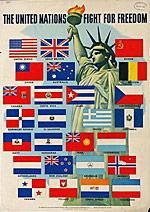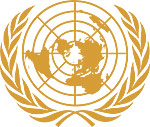
Unit 5: Crisis and Change
Lesson G: Theaters and Consequences of World War II
Activity 6: An Interconnected World: Post-War Division and The United Nations
World War II changed both the social structure and the political alignment of the increasingly interconnected world. Major results of World War II include:
- the creation of the United Nations (UN) to
- foster international cooperation
- prevent future conflicts
- decolonization efforts across Africa and Asia
- the emergence of superpowers - the U.S.S.R. and the United States
- the beginning of the Cold War, which would last for forty-six years.
You will study more about the Cold War in subsequent lessons. For now, the focus is on the United Nations and its relationship to the League of Nations, which preceded it by 26 years.
The United Nations (UN) was formed on October 24, 1945 by the Allies. The intent was to replace the League of Nations, to stop wars between countries, and to encourage and support dialogue among countries. The U.N. comprises multiple organizations that carry out its missions.
The U.N. adopted The Universal Declaration of Human Rights in 1948. This document was intended to be a guide and standard for all member countries.
![]() Directions: The following activity will draw on your understanding of the League of Nations and the United Nations and their role in world affairs. Use the buttons provided to check the latest move or, when you are done, check the whole question.
Directions: The following activity will draw on your understanding of the League of Nations and the United Nations and their role in world affairs. Use the buttons provided to check the latest move or, when you are done, check the whole question.
Page Notes:
[1] Source: This image from http://en.wikipedia.org/wiki/File:Original_United_Nations.jpg is in the public domain.
[2] Source: This image from http://en.wikipedia.org/wiki/File:Emblem_of_the_United_Nations.svg is in the public domain.




